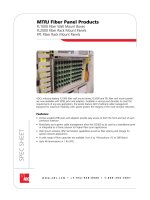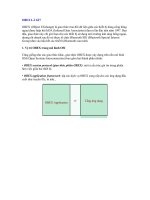Tài liệu Wireless Campus Networks Security pptx
Bạn đang xem bản rút gọn của tài liệu. Xem và tải ngay bản đầy đủ của tài liệu tại đây (2.74 MB, 121 trang )
© 2006 Cisco Systems, Inc. All rights reserved. Cisco Confidential
1
BRKCAM-2010
Wireless Campus
Networks Security
Sujit Ghosh, CCIE #7204
Technical Marketing Engineer
Wireless Networking Business Unit
BRKCAM-2010
© 2006 Cisco Systems, Inc. All rights reserved. Cisco Confidential
2
BRKCAM-2010
HOUSEKEEPING
We value your feedback, don’t forget to complete your online session
evaluations after each session and complete the Overall Conference
Evaluation which will be available online from Friday.
Visit the World of Solutions on Level -01!
Please remember this is a ‘No Smoking’ venue!
Please switch off your mobile phones!
Please remember to wear your badge at all times including the Party!
Do you have a question? Feel free to ask them during the Q&A section or
write your question on the Question form given to you and hand it to the
Room Monitor when you see them holding up the Q&A sign.
© 2006 Cisco Systems, Inc. All rights reserved. Cisco Confidential
3
BRKCAM-2010
Agenda
WLAN Security Overview
WLAN Security Vulnerabilities and Threats
WLAN Security Authentication and Encryption
Unified Wireless Deployment
Wired and Wireless IDS
WLAN Security Best Practices
© 2006 Cisco Systems, Inc. All rights reserved. Cisco Confidential
4
BRKCAM-2010
Hackers/Criminal
Why WLAN Security Is Important?
Lessons:
Do not rely on basic WEP encryption; requirement for enterprise class security (WPA, EAP/802.1x protocols,
Wireless IDS, VLANs/SSIDs, etc.)
Employees often install WLAN equipment on their own (compromises security of your entire network)
Business impact due to stolen data: Potential financial and legal consequences (laws to protect data
confidentiality; example: healthcare, retail, financial, government)`
“War Driving”
Employees
Vulnerabilities:
© 2006 Cisco Systems, Inc. All rights reserved. Cisco Confidential
5
BRKCAM-2010
WLAN Security “Visibility”
Prevalence of technology
PWLAN and other public 802.11 networks
Other security fears—identity theft, phishing, etc.
“Hackers shift focus to financial gain”, Sept. 26, 2005
/>identity.hacker/index.html
Public availability of tools
Example exploit/reconnaissance tools:
www.remote-exploit.org/index.php/Auditor_main
www.wellenreiter.net
Aircrack—WEP key exploit
coWPAtty—WPA-PSK exploit
Kismac—MAC-based implementation
of Kismet
© 2006 Cisco Systems, Inc. All rights reserved. Cisco Confidential
6
BRKCAM-2010
WLAN Security Vulnerabilities
and Threats
© 2005 Cisco Systems, Inc. All rights reserved.
© 2006 Cisco Systems, Inc. All rights reserved. Cisco Confidential
7
BRKCAM-2010
Agenda
WLAN Security Overview
WLAN Security Vulnerabilities and Threats
WLAN Security Authentication and Encryption
Unified Wireless Deployments
Wired and Wireless IDS
WLAN Security Best Practices
© 2006 Cisco Systems, Inc. All rights reserved. Cisco Confidential
8
BRKCAM-2010
WLAN Security Vulnerabilities and Threats
WLAN sniffing/war driving
Encryption vulnerabilities: WEP
Denial of Service (DoS) attacks: using 802.11
de-authentication/disassociation frames,
RF jamming, etc.
Authentication vulnerabilities: dictionary attacks, MITM attacks
Address spoofing: MAC-address spoofing and
IP address spoofing (both hostile/outsider attacks as well as insider
attacks)
Examples of Existing Vulnerabilities and Threats
© 2006 Cisco Systems, Inc. All rights reserved. Cisco Confidential
9
BRKCAM-2010
An Example:
How Does a Wireless Exploit Take Place?
Probe response “listening” (to get SSID)
Passive WEP key sniffing
Initial phases of WLAN security exploit
Discovery of WLAN networks by monitoring for probe/probe
responses
Collection of sufficient encrypted packets, offline processing
and attempt to calculate WEP key
© 2006 Cisco Systems, Inc. All rights reserved. Cisco Confidential
10
BRKCAM-2010
An Example:
How Does a Wireless Exploit Take Place?
For example, “Kismac” tool: offers a “suite”
of exploit tools with a easy-to-use GUI
/> Authentication exploits can then be undertaken, once a
client has been provoked to re-authenticate
Or, if client may be induced to negotiate
unauthenticated/unencrypted connection,
a direct exploit on client may be undertaken
Active De-Auth to Induce Clients to Probe
(Reduces Time to Overcome SSID “Cloaking”)
© 2006 Cisco Systems, Inc. All rights reserved. Cisco Confidential
11
BRKCAM-2010
WLAN Sniffing and SSID Broadcasting
The Simplest Type of WLAN Exploit
• However, given the “open” characteristics of 802.11 association
behavior, one that is not easily fixed
• Disabling SSID “broadcast” simply overcomes passive sniffing; SSID
is easily discovered by observing probe responses from clients
• Thus, SSID “cloaking” shouldn’t be considered a security mechanism
© 2006 Cisco Systems, Inc. All rights reserved. Cisco Confidential
12
BRKCAM-2010
802.11 WEP Vulnerabilities
802.11 Static-WEP is flawed: encryption passive attacks
RC4 Key Scheduling algorithm uses 24-bit Initialization Vector (IV) and does not rotate encryption keys
Practical tools that have implemented FMS attack (example: AirSnort) can uncover the WEP key after
capturing 1,000,000 packets
This is about ~ 17 minutes to compromise the WEP key in a busy network;
this attack is passive and all the attack tool needs to do is “listen” to the WLAN network (i.e., sniff WLAN
packets)
802.11 Static-WEP is flawed: encryption active attacks
Does not protect the WLAN user data integrity
Several forms of attacks possible: Replay attacks, bit-flipping attacks, etc.
802.11 Static-WEP shared key authentication is flawed
AP challenges (plaintext challenge) the WLAN user to ensure possession of valid encryption key
Attacker can obtain key stream Î plaintext challenge XOR ciphertext = Key Stream
© 2006 Cisco Systems, Inc. All rights reserved. Cisco Confidential
13
BRKCAM-2010
WLAN Denial of Service (DoS) Attacks
RF jamming
A simple RF jamming transmitter (example: microwave or codeless phone next
to an AP)
DoS attacks using 802.11 management frames
In current implementations, 802.11 management frames
are not authenticated between the AP and the clients
Anyone can spoof a client’s MAC address and send an 802.11 management
frame on behalf of that client
802.1x authentication flooding
An attacker can send a flood of 802.1x authentication
requests to the AP
This causes the AP to process unnecessary
authentication frames
© 2006 Cisco Systems, Inc. All rights reserved. Cisco Confidential
14
BRKCAM-2010
Man-in-the-Middle Exploits
Attacker must first force client off of intended network in order to lure
wireless station to associate to “rogue network”
Attacker attempts to obtain security credentials or security key by
intercepting credentials
Wireless
Station
Access
Point
MiTM Attacker
EAP
Server
Man-in-the-Middle Exploits Are Attacks by Which the
Attacker Poses as the Network to Clients and as a
Client to Network
© 2006 Cisco Systems, Inc. All rights reserved. Cisco Confidential
15
BRKCAM-2010
Rogue AP Vulnerability:
Both Internal and External Sources
Frustrated insider
User that installs wireless AP in order to benefit
from increased efficiency and convenience it offers
Common because of wide availability of
low cost APs
Usually ignorant of AP security configuration,
default configuration most common
Malicious hacker
Penetrates physical security specifically to
install a rogue AP
Can customize AP to hide it from detection tools
Hard to detect—more effective to prevent via 802.1x
and physical security
More likely to install LINUX box than an AP
Jones from Accounting
> 99.9% of Rogue APs
< .1% of Rogue APs
© 2006 Cisco Systems, Inc. All rights reserved. Cisco Confidential
16
BRKCAM-2010
Authentication Vulnerabilities
Dictionary attacks
On-line (active) attacks: active attack to compromise passwords
or pass-phrases
Off-line attacks: passive attack to compromise passwords or
pass-phrases
MITM attacks
Active attacks: an attacker attempts to insert himself
in the middle of authentication sequence
Can be employed in 802.1X as well as PSK
environments
© 2006 Cisco Systems, Inc. All rights reserved. Cisco Confidential
17
BRKCAM-2010
What Is a Dictionary Attack Tool?
What is a dictionary?
Contains variations of passwords
Weak passwords can be cracked using standard dictionaries (found easily in
various Internet discussion forums and web sites)
Success factors for this tool depend on:
Variation of the user’s password must be found in the dictionary used by the
attacker
Attacker’s experience and knowledge in generating dictionaries
Password strength
A weak six character password will be easily compromised compared to a
strong ten letter password
Attacker’s dictionary strength determines whether the password can be
compromised
© 2006 Cisco Systems, Inc. All rights reserved. Cisco Confidential
18
BRKCAM-2010
Address Spoofing
As with wired networks, MAC address
and IP address spoofing are possible in
WLAN Networks
Outsider (hostile) attack scenario
Does not know key/encryption policy
IP Address spoofing is not possible
if Encryption is turned on (DHCP messages are
encrypted between
the client and the AP)
MAC Address spoofing alone (i.e., without IP
Address spoofing) may not buy much if
encryption is turned on
Insider attack scenario:
Seeking to obtain other’s secure info
MAC address and IP Address spoofing will not
succeed if EAP/802.1x authentication is used
(unique encryption key is derived per
user (i.e., per MAC address))
Authorized
Client
Sniff Client
MAC Addr
and IP
Address
Inject Packets into
the WLAN Network
Using Client’s
MAC/IP Address
Access
Point
© 2006 Cisco Systems, Inc. All rights reserved. Cisco Confidential
19
BRKCAM-2010
Exploits Using 802.11 as a Launchpad
Standard Layer 2 exploits, e.g., Dsniff, Nmap
Penetration test—server and service vulnerabilities:
Metasploit project—open source RPC injector
Immunity CANVAS
Core security technology impact
Application security—exploit/malware
Specific examples that have been launched:
Installation of various viruses, worms, and other malware, thereby complicating
detection—Security Conference, Canfield University, UK
Simple sniffing of unencrypted user ID, passwords, account
nos., etc.—Wi-Fi hotspots
© 2006 Cisco Systems, Inc. All rights reserved. Cisco Confidential
20
BRKCAM-2010
WLAN Security Vulnerabilities and
Threats Summary
Wireless LANs have become easy targets for
both “traditional” network exploits, as well as
criminal element
Passive SSID probe sniffing and WEP key attacks
are just the first stage in WLAN exploits
More sophisticated WLAN exploits are likely to
employ management frames, as there is currently
no encryption capable for these 802.11 media
management packets
If an attacker can gain access to a WLAN, it is
possible to launch a variety of higher-layer exploits
over this media
© 2006 Cisco Systems, Inc. All rights reserved. Cisco Confidential
21
BRKCAM-2010
WLAN Security Authentication
and Encryption
© 2006 Cisco Systems, Inc. All rights reserved. Cisco Confidential
22
BRKCAM-2010
Agenda
WLAN Security Overview
WLAN Security Vulnerabilities and Threats
WLAN Security Authentication and Encryption
Unified Wireless Deployment
Wired and Wireless IDS
WLAN Security Best Practices
© 2006 Cisco Systems, Inc. All rights reserved. Cisco Confidential
23
BRKCAM-2010
Characteristics of Self-Defending
Network
Secure infrastructure
Trusted and secure
communications
Autonomic policy
deployment and enforcement
Adaptive threat
response
Si
Si
Si
Si
Intranet
Internet
© 2006 Cisco Systems, Inc. All rights reserved. Cisco Confidential
24
BRKCAM-2010
Basic Requirements to Secure
Wireless LANs
Protection of the WLAN network—Management Frame Protection
(MFP) and Wireless IDS
Protect the network from external sources and devices not controlled
by infrastructure (secure infrastructure)
Protection of the WLAN devices and managed user/device
connectivity
Encryption/authentication of managed 802.11 devices
Authentication framework—framework to facilitate authentication messages
between clients, access point, and AAA server
Authentication algorithm—mechanism to validate client credentials
Encryption algorithm—mechanism to provide data privacy
Message integrity—ensures data frames are tamper free and truly originate
from the source address
© 2006 Cisco Systems, Inc. All rights reserved. Cisco Confidential
25
BRKCAM-2010
Basic Requirements to Secure
Wireless LANs
Beyond authentication and encryption of client devices
(L2), protect client devices and network from malicious
s/w
Operating system/service/application security
Network Admission Control and Client Shunning are
examples
Not specifically a wireless function, but enforcement
can be provided by wireless network
Protection of the Managed Clients









